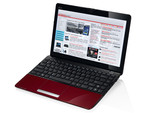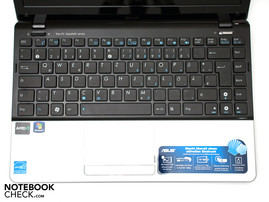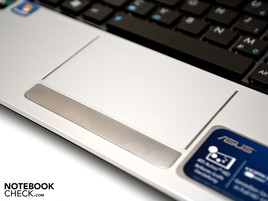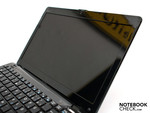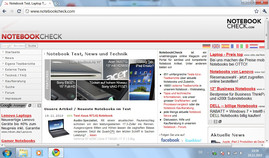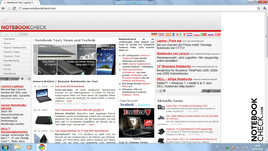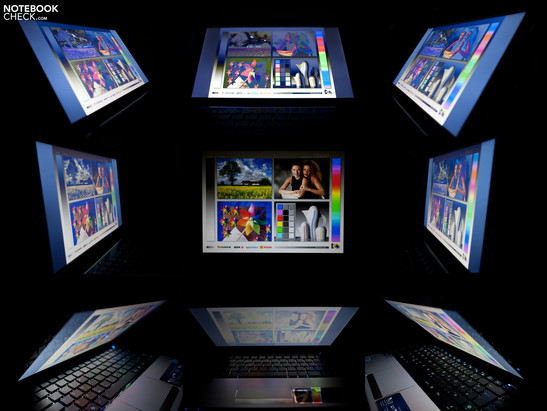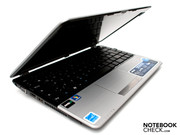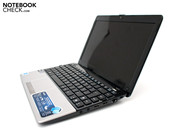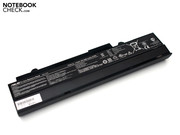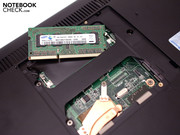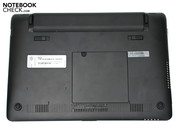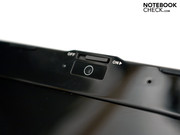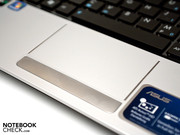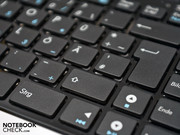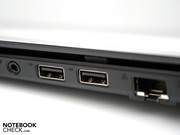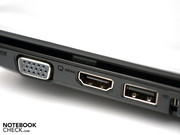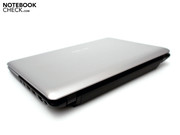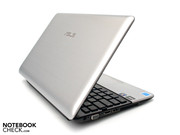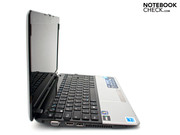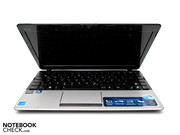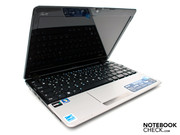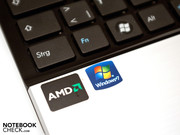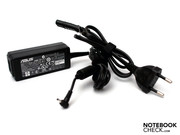Review Asus Eee PC 1215T Netbook

The latest Eee PC lineup with AMD hardware was introduced in the beginning of October. Among them, the smaller Asus Eee PC 1015T (detailed review) with an AMD V105 processor and ATI Radeon HD 4250, as well as a large 12 inch device. The Asus Eee PC 1215T is equipped with a 12.1 inch screen (glare-type, 1366x768 pixels). It is at the upper limits of netbooks due to the hardware configuration and could actually be ranked as a subnotebook. The new device is equipped with an AMD Athlon II Neo K125 Prozessor (single core, 1.7 GHz) and ATI's graphics chip set, HD 4250.
Other novelties of this generation are a modern HDMI port for transmitting high resolution video and audio materials, a revised design based on the 10 inch models and a DDR3 RAM. The colors haven't been modified and the 1215T is still available in black (matt and glossy), silver (matt) and red (glossy).
Beside the processor and the graphics unit, a 2 GB DDR3 10600S RAM (1066 MHz) and a 2.5 inch hard disk with 250 GB are installed ex-factory. State of the art WLAN standard 802.11 b/g/n and Bluetooth 3.0 +HS are also onboard. The light 1.5 kilogram Asus Eee PC 1215T has been in retail since the end of October, 2010 and is sold for 449 euro (RRP) including value added tax. Can the AMD maintain itself against the allegedly stronger Asus Eee PC 1215N with Nvidia ION 2 and dual core processor? Is it a good alternative or just another product of Asus' vast Eee PC portfolio?
Case
Asus sticks to the new models current design and uses the familiar case of Asus Eee PC 1215N without making any modifications. Depending on preferences, the device can be bought in black or red with a glossy finish, and in black or sliver with a matt finish. A trend towards matt netbooks is evident, though. These models are less susceptible for dust, fingerprints and scratches. Inside, the keyboard's and display's area have been given a high-gloss variation despite the matt finish on the exterior. This finish makes the device look very elegant, but fingerprints and reflections are especially annoying in this area. Asus should stick with the matt finish here and forgo on high-gloss lacquer.
The haptics and workmanship are impressive and there aren't any uneven gaps. The material makes a pleasant impression, despite the use of plastic, and the silver model's aluminum appearance additionally loosens the looks. The case stability in the keyboard's area is impressive. In comparison, the display lid can easily be depressed and twisted. Opening isn't possible due to the weight distributed towards the rear and the lower half has to be held down. The display hinges also make a good impression, whereby a teetering of the display can't be prevented.
The case bottom has a large maintenance cover. The fact that a 2 GB DDR3 RAM is installed ex-factory and that there is no second bank available for another bar is interesting. Thus, the cover doesn't make much sense. However, we don't understand why Asus has omitted a second RAM bank. The size of 29.6 x 20.3 x 3.8 centimeters (w x d x h) and the weight of 1.5 kilograms, including a 6 cell battery with 47 watt hours haven't changed in comparison to the Intel counterpart.
Connectivity
The connectivity corresponds to a good standard, whereas there are no USB 3.0 or eSATA ports. The case's left side accommodates the power socket for the included adapter, an analog video out (VGA), a modern HDMI port for a state of the art flat screen TV, an USB 2.0 interface and the usual 3-in-1 cardreader from Asus. It supports today's standard SD, SDHC and MMC memory cards.
The audio sockets (headphone out, microphone in) without S/PDIF support, two more USB ports (version: 2.0), an RJ-45 network socket and a Kensington Lock slot are on the opposite side. As typical for Asus, the front and rear are free from any other ports. Merely the status LEDs, respectively the large 6 cell battery that takes up the entire rear are found there. The seashell case's wedge shaped design doesn't provide any possibility to place any ports there, anyway.
Asus has done a good job with the distribution of the available interfaces and the positioning is convincing. Problems with cables are prevented because the ports have been placed as far back as possible. Too bad that Asus doesn't offer the missing USB 3.0 port(s) as a surcharge option for the Eee PC 1215T.
Communication
The options for data sharing hardly leave anything to be desired. The 1215T bids a somewhat older and thus slower 10/100 Ethernet via a controller from Atheros (AR8152) for cabled communication. The netbook also supports WLAN standard 802.11 b/g/n (Atheros AR9285 Controller) and fast Bluetooth 3.0 +HS. However, you have to do without a 3G UMTS module in this netbook.
Supplies
The scope of delivery is, as expected, still small. The most necessary for an immediate start is included. The matching adapter with power cable, the 4400 mAh, 6 cell battery, the warranty card and the user's manual are found beside the device. There aren't any small extras like a case or mobile mouse. They have to be purchased additionally for an extra charge.
Warranty
Asus' warranty covers two years including pickup & return service. Sending the device to Ratingen in a warranty case is free with this service in Germany. If you like, you can bring the netbook to the next DHL office or Asus initiates an onsite pickup. There is an Asus support site for Eee family products for a smooth transaction. Despite the two year warranty, the battery is only protected for 12 months.
Input Devices
Keyboard
Asus has used the chiclet keyboard and touchpad from the Intel model without modifications. The layout is overall a bit bigger than the keyboard in the Asus Eee PC 1015PN with a 10 inch display. The key size of 14x14 millimeters is the same, but the layout looks straightened and the arrow keys' size have been adjusted. The pressure point and stroke length are still convincing and you quickly accommodate. The FN functions are clearly highlighted by small, light blue symbols and they are easy to use.
Touchpad
The touchpad continues to be a very good mouse replacement for the netbook and doesn't have to hide from larger notebooks. The new multi-touch gestures are supported and the setting options in the Synaptic's system control are extensive. The mouse replacement keys are hidden in a large control bar with aluminum look. The pressure point is stiff and the feedback could be better.
Display
A netbook is particularly conceived for mobile use and the display plays an important role in this application field. It should ideally have a matt surface and good measuring rates. Asus can't meet up to all of these criteria and uses a 12.1 inch LED screen that has a high-gloss surface. The native resolution is 1366x768 pixels (WXGA), which allows an internet site to be displayed in its full width (see pictures for comparison). Interpolated resolution levels can't be selected under Microsoft Window 7 Home Premium.
The integrated LED backlight isn't particularly bright. The maximum rate of 150 cd/m2 is in the broad midfield and nothing special. The average rate of 142.8 cd/m2 doesn't stand out from displays in smaller 10 inch Eee PCs. They bid about 230 cd/m2 and are thus much brighter. Even the immediate opponent, Asus Eee PC 1215N with ION 2 graphics, has a display that is a bit brighter.
Comparison of resolutions: 1024x600 pixels (left) - 1366x768 pixels (right)
| |||||||||||||||||||||||||
Brightness Distribution: 89 %
Center on Battery: 147 cd/m²
Contrast: 233:1 (Black: 0.63 cd/m²)43.81% AdobeRGB 1998 (Argyll 2.2.0 3D)
63.1% sRGB (Argyll 2.2.0 3D)
42.71% Display P3 (Argyll 2.2.0 3D)
The measured brightness rates are very tight and there aren't any significant fluctuations. This results in an illumination of 89 percent. The black reproduction is blemished by a slightly increased black value (0.63 cd/m2) and there is a gray cast. A contrast of 233:1 is acceptable for a glare-type screen, but it is nevertheless in the broad midfield of average displays.
The reproducible color spectrum can be determined by a special tool (hardware and software), which is called X-Rite i1Display 2 in this case. Asus Eee PC 1215T's ICC profile shows that it's not suitable for professional use. At least the sRGB color space should be covered for this intention. The Eee PC does well in comparison to the MSI CX620MX multimedia notebook.
Outdoor use is limited because of the glossy display surface. Working outdoors in direct sunlight isn't possible due to average display rates. The surroundings are clearly reflected and the content is hardly legible. Working in indirect light is very possible, whereas you have to accept a few losses in comfort. A stronger backlight could have partly compensated this weakness.
The viewing angle stability isn't surprising and can only convince to a part. The horizontal reproduction remains stable even in narrow angles and colors don't falsify. In comparison, problems turn up quicker on the vertical plane. A slight deviation suffices to invert the image. This characteristic creates the impression of a negative.
Performance
The Asus Eee PC 1215T is the second netbook from Asus with a 12 inch display and AMD hardware. The predecessor, Eee PC 1201T was equipped with a weaker AMD MV-40 and wasn't really impressive. Asus relies on a stronger AMD Athlon II Neo K125 with 1.7 GHz in one core (single core, 1 thread) in the second try. This entry level CPU is especially a competitor for the single core Atom processors because they usually work with an incorporated Intel GMA 3150. Unfortunately, the power consumption is the AMD component's drawback. The nominal power dissipation (TDP) is a maximum of 12 watt and that is about 5.5 watt more than the comparable Intel Atom N455 with an incorporated graphics unit.
The ATI Radeon HD 4250 integrated into the chipset (AMD RS880M) is still responsible for the graphics. It clearly stands out from Intel's processor graphics (GMA 3150) with a core rate of 500 MHz. Current 3D games can be executed due to DirectX 10.1 and Shader 4.0, but smooth gaming is only possible with minimum graphics settings. HD rendering is taken care of by the incorporated UVD 2 video decoder.
Inside, beside the processor and graphics unit, there is a 2.5 inch drive from Western Digital with a capacity of 250 GB and a 2 GB DDR3 10600S RAM. The stronger Asus Eee PC 1215N bids the option of upgrading the RAM to 4 GBs due to two slots. However, the new AMD model doesn't have a second RAM bank. It's already equipped with 2 GB ex-factory and the maximum is thus exhausted. The user can't access the installed hard disk. Replacing it is very difficult if not impossible.
A good basis for comparison is created after numerous current and also older benchmarks. The application performance has increased significantly in comparison to the AMD predecessor (Eee PC 1201T, 1409 points). It is within an acceptable range for a netbook with 1760 points in the latest PCMark Vantage. The AMD Eee also convincing in comparison to the Asus Eee PC 1215N with ION 2 graphics. However, you have to consider that the AMD Athlon II Neo K125 only has one thread and multitasking isn't its ideal hunting grounds. Another device in its immediate vicinity is the Acer Aspire One 521 netbook with a 10.1 inch display.
| PCMark 05 Standard | 2238 points | |
| PCMark Vantage Result | 1760 points | |
Help | ||
The synthetic gaming benchmarks from Futuremark certify the expected rates in the entry level. Thus, you shouldn't expect too much from the installed graphics card. 3DMark06 rewards 1016 points in a resolution of 1280x1024 pixels. Devices with similar AMD hardware, such as Acer's Aspire 1551 subnotebook or Lenovo's IdeaPad U160 with an Intel Core i5-520UM and Intel GMA HD graphics, are on par. The Asus Eee PC 1215N with a dedicated graphics unit stands out clearly from these configurations with 2409 points.
| 3DMark 2001SE Standard | 6344 points | |
| 3DMark 03 Standard | 2652 points | |
| 3DMark 06 Standard Score | 1016 points | |
Help | ||
Asus uses a Western Digital Scorpio Blue (model: WD2500BEVT-80A23T0) for the hard disk. This drive has a capacity of 250 GB and rotates with a maximum of 5400 revolutions per minute. The HDTune Pro 4.6 benchmark determines a maximum transfer rate of 77.5 MB per second (read). The Scorpio Blue, alike a few other drives, has proven itself for netbook use because the performance is sufficient for routine applications. Replacing it for a faster drive or a solid state drive is hardly possible due to the closed case.
HD Video and Gaming Verdict
The fact that the weak processor with one thread is compensated by the ATI Radeon HD 4250's performance is surprising. Because of this fact, HD rendering is made possible, even if only just. Local rendering of a 1080p video (H.264) isn't a problem and the processor's capacity is 5%. The latest HD movie trailer from "Harry Potter and the Deathly Hallows" on YouTube is possible in 1080p (1920x796 pixels, 448 kbps), but the hardware meets its limits (frame drops). The processor is loaded to 78 percent on average and there aren't any reserves left for additional applications (multitasking).
The pure gaming performance is acceptable if you start current games, such as Starcraft II - Wings of Liberty, in minimum resolution and low details. You also have to select the minimum settings for the popular MMORPG, World of Warcraft, from Blizzard. You should prefer devices with a dedicated graphics unit for longer excursions. The Alienware M11x subnotebook of the second generation is a prime example in this field. However, it blows the budget with 1600 euro.
Emissions
System Noise
The small fan on the left does its work fairly quietly. It's either deactivated or whirs quietly along in normal use. The maximum rate in this performance field is 31.8 dB(A) and is inconspicuous. The 2.5 inch drive from WDC also rotates quietly with 32.8 dB(A) and is only slightly audible in a silent room. The noise level increases to a maximum of 34.6 dB(A) under load and you can hear the device. This rate can't be described as disturbing and other problems (loud transistors, a unevenly running fan) don't turn up.
Noise Level
| Idle |
| 31.3 / 31.3 / 31.8 dB(A) |
| HDD |
| 32.8 dB(A) |
| Load |
| 33.4 / 34.6 dB(A) |
 | ||
30 dB silent 40 dB(A) audible 50 dB(A) loud |
||
min: | ||
Temperature
A large copper cooling unit, which you can partly see underneath the maintenance cover on the bottom, does a good job. You notice a slight heating on the bottom in normal use, but there is no reason for complaint. The plastic bottom heats up with increasing load. It's still within an acceptable range with a maximum of 35.0 degrees Celsius and the ergonomics isn't impaired. You don't notice anything of this manner in the wrist-rest or keyboard area.
(+) The maximum temperature on the upper side is 30.2 °C / 86 F, compared to the average of 33.1 °C / 92 F, ranging from 21.6 to 53.2 °C for the class Netbook.
(+) The bottom heats up to a maximum of 35 °C / 95 F, compared to the average of 36.6 °C / 98 F
(+) In idle usage, the average temperature for the upper side is 24.6 °C / 76 F, compared to the device average of 29.8 °C / 86 F.
(+) The palmrests and touchpad are cooler than skin temperature with a maximum of 26.8 °C / 80.2 F and are therefore cool to the touch.
(+) The average temperature of the palmrest area of similar devices was 29.3 °C / 84.7 F (+2.5 °C / 4.5 F).
Loudspeakers
Two stereo loudspeakers are responsible for internal audio rendering. Their qualities aren't convincing. The trebles are present and their playback is alright, but deep pitches and basses don't exist. You should use either the 3.5 mm jack or the newer HDMI port, depending on your requirements, for a better sound quality via external loudspeakers.
Battery Life
The installed hardware's consumption rates are slightly increased. Weaker devices with Intel's Atom N455 are impressive with a lower power dissipation (6.5 watts - TDP). The AMD Athlon II Neo K125 is listed with a maximum of 12 watts (TDP) without graphics unit. The 1215T is quite competitive in ideal mode and need a maximum of 13.5 watts. The consumption increases obviously under load and is, with 27.3 watts, in the field of smaller subnotebooks with a ULV processor.
This increased power requirement can't completely be compensated by a 6 cell battery with 47 watt hours. Batteries with the same capacity are also used in Asus netbooks with a 10 inch display. A compromise has to be made because a larger lithium ion battery would increase the weight and thus limit mobility.
| Off / Standby | |
| Idle | |
| Load |
|
The "Classic Test" of the little tool, BatteryEater, simulates the maximum hardware load. An OpenGL calculation with maximum display brightness is executed for this. The last reserves are tickled out of the system with Windows 7's high performance profile and the "Super Performance Mode" of the pre-installed Super Hybrid Engine. The limit is reached after a poor 2 hours and 14 minutes and the included adapter has to be connected. You have an acceptable 4 hours and 23 minutes for checking your emails and normal internet surfing. This setting is the main application field for a netbook and correlates to routine use.
BatteryEater's "Reader's Test" (maximum possible battery life, minimum display brightness, energy saving options, disabled mobile technologies) certifies an acceptable runtime of 5 hours and 29 minutes. Nevertheless, the Asus Eee PC 1215N has to be preferred in this application field. This configuration is impressive due to the automatic graphics switching with Intel's energy saving GMA 3150. Depending on the use, the 1215T looses between 20 and 30 minutes of battery life in comparison to the Intel netbook.
Verdict
The Asus Eee Pc 1215T can be called a successful second try. The predecessor's weaknesses have either been remedied or improved. Now office suitable hardware is supplied in the familiar chassis, which even allows HD video rendering. The connectivity and low emissions are impressive. You'll have to accept losses in mobility, though. The glare-type screen isn't convincing and the battery life isn't overwhelming.
The AMD alternative can't maintain itself against the somewhat more expensive Asus Eee PC 1215N. In particular, the lack of a second bank for an additional RAM and the smaller single core processor with only one thread have to be criticized. Asus' generous input devices and good workmanship don't give reason for complaint. You get an elegant AMD netbook with nice feature, but also big flaws that shouldn't happen, for a recommended retail price of 449 euro including value added tax. A look at less expensive CULV notebooks for about 500 euro might be worthwhile in certain situations.


 Deutsch
Deutsch English
English Español
Español Français
Français Italiano
Italiano Nederlands
Nederlands Polski
Polski Português
Português Русский
Русский Türkçe
Türkçe Svenska
Svenska Chinese
Chinese Magyar
Magyar